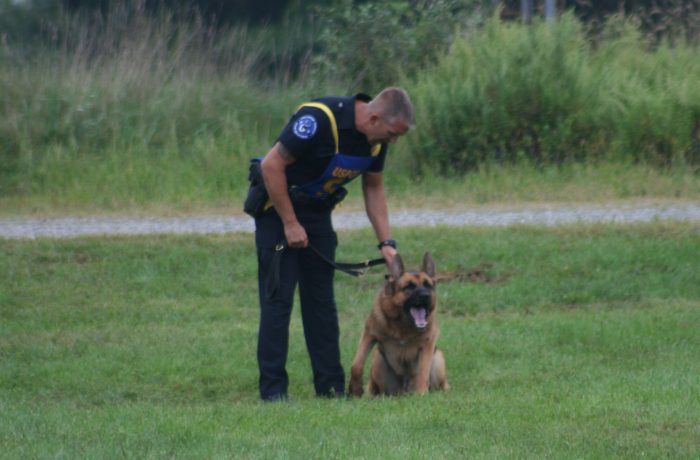By Leischen Stelter, editor of In Public Safety
For 28 of his 31 years in law enforcement, Robert Dougherty Jr. has worked with police dogs. As an officer for the Cheltenham Township Police Department, located outside of Philadelphia, he started his career as a handler and is now one of two head K9 trainers for the department. In addition to being a full-time officer, he teaches criminal justice courses at American Military University.
When Dougherty started in 1988, most dogs were trained as single-purpose patrol K9s. That is, they were trained to find narcotics, or explosives, or dead bodies, or fleeing suspects. However, in the last 10 years, most police departments have adopted cross-training programs so K9s are proficient in several areas of detection. While some departments still have single-specialty dogs, most K9s today can do more than one type of task.

This has meant major changes in how dogs and handlers are trained. “There’s been a shift away from a compulsive training method,” said Dougherty. “Compulsion is force. So officers would compel a dog, through leash pressure or other means, to do what the officer wanted the dog to do.”
These days, there is a lot more positive reinforcement incorporated into K9 training. For example, trainers use food or toys to motivate dogs and reward them for performing a task. “This came out of the civilian side of sports training for dogs and competitive obedience and agility competitions,” said Dougherty. “Law enforcement saw how well that was working and it enabled them to better train police dogs.”
Dogs undergo rigorous training, as do handlers. “We teach dogs and handlers at the same time. A new dog gets a new handler and they learn everything together,” said Dougherty.
Both dog and handler have their own responsibilities. Dogs must detect what they are trained to detect, but handlers must know how to read their dog. That’s no easy task. Handlers must be extremely observant to identify changes in the dog’s behavior. For example, certain behavior in a dog indicates detection of hidden narcotics, whereas another behavior indicates the presence of a person. “Handlers must be tactically aware of how their dog’s behavior changes, because they’re asking their dog to go into potentially dangerous situations,” said Dougherty.
Having a K9 unit requires extensive initial training as well as ongoing maintenance training. On average, K9s and handlers go through 400 hours of training for patrol work and an additional 320 hours for narcotics, explosives and cadaver training. Most states require dogs to have 16 hours of maintenance training per month.
What to Look for in a Police Dog
Knowing what characteristics to look for in a police dog is critical, said Dougherty. Agencies invest a lot of money and time on K9 training and want to make sure a dog has the ability to meet the rigors of life as a police dog.
“Genetics are extremely important,” said Dougherty. Dogs must be genetically healthy — they cannot be prone to physical issues like hip dysplasia or cancer, whenever possible. Dogs must also have the right drives and temperament. “You want a dog that has a high drive to do things like search, but also a balanced personality that allows them to be approachable and social,” said Dougherty. The majority of police dogs are German Shepherds, Labrador Retrievers, Dutch Shepherds and Belgian Malinois. These breeds tend to be high-drive dogs that are bred to work and are also athletic dogs.
Caring for Police K9s
How an agency treats its K9s can contribute to its health and longevity of service. “In my opinion, you get a more balanced dog when agencies allow it to go home with its handler and live with a family. These dogs tend to have a more balanced life — they have a job and go to work and they come home to a social life, just like its handler,” he said. These dogs are around other people, live in neighborhoods and are exposed to a more well-rounded and normal life.
Dogs that live in a kennel are more likely to suffer from separation anxiety and display more behavioral problems and physical illnesses due to stress. “At its foundation, K9 training is a bond between dog and handler. When that bond is broken and the dog is separated from its handler, it causes stress on the animal,” said Dougherty.
K9 Training Beyond Law Enforcement
Dougherty’s passion for training police K9s has spanned decades, but his interest in the capabilities of dogs goes beyond law enforcement. He also works with the Penn Vet Working Dog Center, a non-profit organization associated with the University of Pennsylvania. This organization recently collaborated with medical staff to train dogs to detect ovarian cancer. “We know that dogs are able to detect and isolate cancer cells,” he said. Scientists are trying to isolate what it is that dogs can smell in a cancer cell so a test or diagnostic equipment can be developed to help doctors detect ovarian cancer early.
Being involved in training dogs, whether in law enforcement, search and rescue, or medical detection, is an exciting field and have the potential to save lives or improve the quality of life for many people.

Comments are closed.